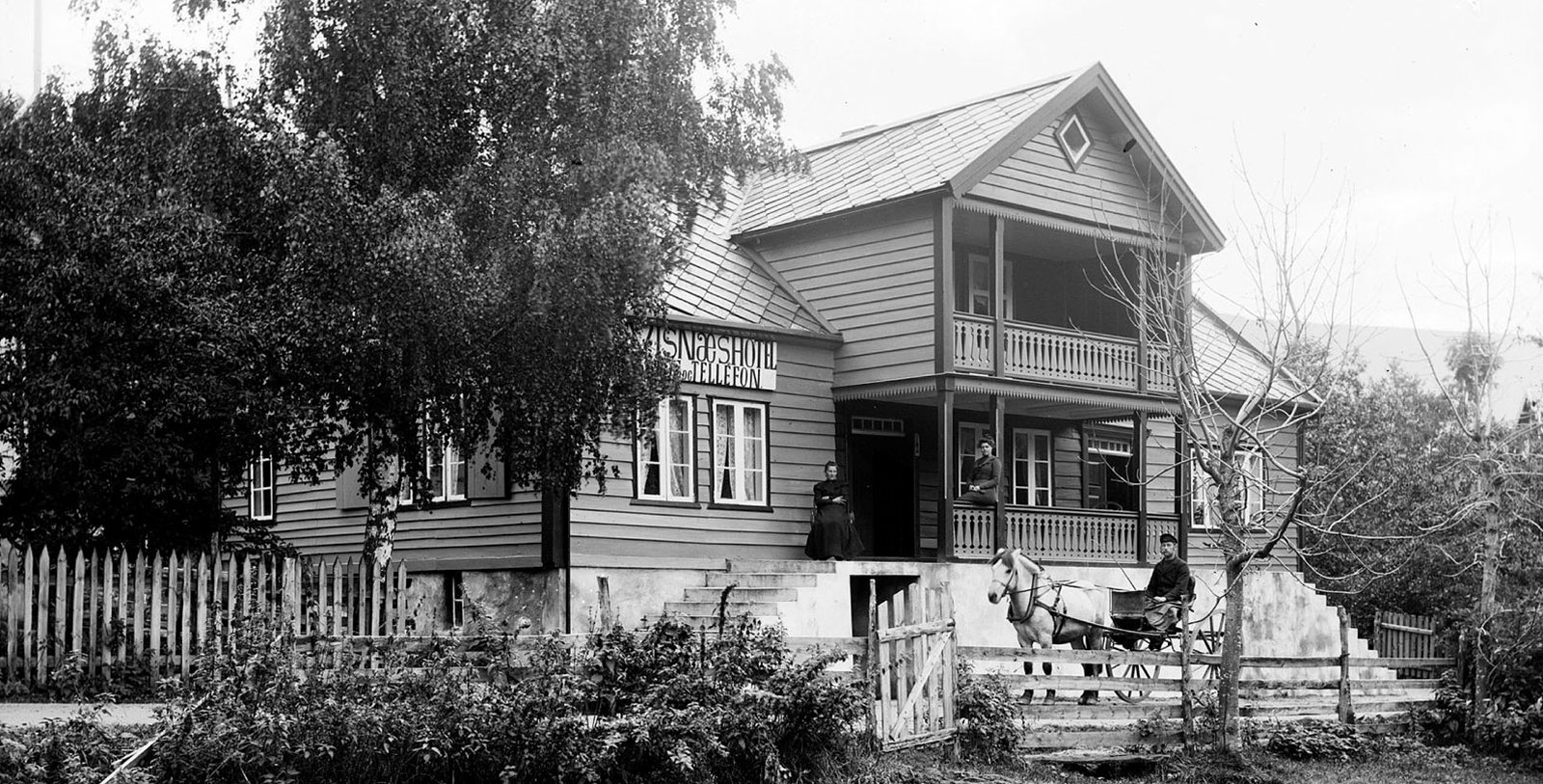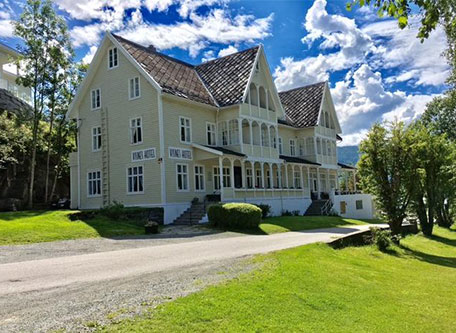Receive for Free - Discover & Explore eNewsletter monthly with advance notice of special offers, packages, and insider savings from 10% - 30% off Best Available Rates at selected hotels.
history
Discover Visnes Hotel Stryn, which is located in the innermost part of the majestic Nordfjorden.
Visnes Hotel Stryn, a member of Historic Hotels Worldwide since 2022, dates back to 1850.
VIEW TIMELINEA member of Historic Hotels Worldwide since 2022, Visnes Hotel Stryn is among the most amazing places to stay in Norway’s beautiful Vestland region. Indeed, this magnificent destination is close to many cultural attractions that enchant countless visitors every year, including the famous Jostedalsbreen nasjonalpark (Jostedalsbreen National Park). Guests can even marvel at the majesty of the renowned Nordfjorden, which is located just beyond the hotel’s front door! But long before the structure debuted as a luxurious boutique hotel, it was once the main house for a sprawling farmstead. A farmer named Anton Visnes had specifically built the structure in 1850, which overlooked the verdant fields of his estate. To make a little extra money, he began renting a few of his bedrooms to various travelers who were passing through the area. Word gradually spread of Visnes’ hospitality, which lured greater numbers of people to book a room. The uptick in business convinced Anton to transform the house into an actual hotel in 1887. In fact, Anton even felt obligated to expand the size of the building considerably to feature a series of “modern” guestrooms!
The hotel prospered for many decades thereafter, with more merchants and tourists arriving in greater numbers from places as far away as Bergen. Anton’s relatives continued to manage the business, too, diligently preserved the reputation that he had developed years before. They subsequently presided over several renovations to maintain the building’s longevity, including the construction that saw the implementation of its iconic Swiss-inspired façade. (Interestingly, the family operated a gas station and garage to service any automobiles that the guests might have brought!) Then in 2014, the Visnes family ultimately sold the hotel to married couple Marit Nordheim Otterdal and Arvid Otterdal after operating it for six generations. The Otterdals vowed to carry on the legacy of the Visnes family, as well as to preserve the building’s rich architectural integrity. The couple proceeded to launch a massive restoration that brilliantly expanded upon the hotel’s wonderful amenities, while also incorporating other historic structures on-site into the compound, like the Victorian-era barn. Now known as the “Visnes Hotel Stryn,” the Otterdals’ continue to operate this fantastic historic site to great acclaim.
-
About the Location +
Visnes Hotel Stryn resides in the heart of western Norway, one of the five principal regions that culturally define the country today. Its most well-known historical era coincided with the rise of the Vikings—a seafaring people active throughout Europe during the Middles Ages. Technological innovations in Norway’s western counties effectively increased local agricultural activity, and thus the size of its population. New land to distribute became increasingly rare, forcing the inhabitants to look to the sea for opportunity. Using a uniquely slim, single-mast vessel known now as the “Scandinavian longship,” hundreds of people subsequently departed western Norway to distant destinations. One common practice of the Vikings was to raid the shoreline of Europe for resources. Some of those warriors succeeded in carving out feudal fiefdoms—including powerful kingdoms—within the areas they conquered. But many others peacefully interacted with different European societies, establishing trading posts all over the continent. The Vikings were even known to harbor merchant colonies as far away as central Russia and the Middle East. A few adventurous bands of Vikings also sailed for long distances to remote landmasses like Iceland and Greenland, which they settled starting in the 10th century. In fact, modern archeological evidence has revealed that the Vikings managed to colonize Newfoundland, calling the location “Vinland” in contemporary accounts.
While the age of the Vikings has long since ended, many sites around western Norway still preserve the rich history that they left behind. One of the most enduring landmarks to this heritage is the medieval Urnes Stave Church, located a couple hours away at the end of the Sognefjord. A UNESCO World Heritage Site, the Urnes Stave Church was first built during the 12th century. Many scholars believe the building is among the best surviving examples of Viking culture, especially as it evolved throughout the High Middle Ages. (The church is still occasionally used for special events, although it stopped providing regular services in the 19th century.) Nevertheless, modern western Norway is also a popular tourist attraction due to its wealth of natural wonders. Indeed, the region is widely celebrated for its fjords—long, deep waterways that receding masses of ice cut into the earth eons ago. Known for their beauty, the fjords are the region’s most enduring physical feature. The United Nations have even identified two of the largest fjords in the area—Geirangerfjord and Nærøyfjord—as another respected UNESCO World Heritage Site. Other fascinating geographic landmarks reside in western Norway as well, with the most notable being the Jostedalsbreen, or Jostedal Glacier. The largest glacier of its kind in continental Europe, Jostedalsbreen is accessible to travelers through numerous visitors centers affiliated with the Jostedalsbreen nasjonalpark (Jostedalsbreen National Park).
-
About the Architecture +
This wonderful historic inn showcases elements of what is now referred to as “Swiss chalet” architecture. Swiss chalets were once rustic cottages that first emerged as seasonal farmhouses around the height of the Middle Ages. Indeed, the chalet was a refuge for Swiss cattle herders, who would bring their livestock up into the Alps during the warmer months. The house itself functioned as a secondary home, within which the farmers would create a variety of dairy products for trade. But the chalets lost their original purpose as time passed, gradually turning into quaint seasonal vacation homes. The main reason behind the transformation was the emergence of the Alps as a popular tourist destination in the 19th century, specifically among the British and the French. They eventually discovered the many chalets scattered around the country and began buying them up in great numbers. The foreigners subsequently renovated the chalets to reflect their romanticized views of alpine life in Switzerland. Soon enough, the new iteration of the chalet had swept across the country. Many natives went as far as to alter their own homes to resemble the aesthetic, essentially making the architecture “Swiss” in the process. Many large-scale commercial buildings in Switzerland eventually showcased the style, too, including restaurants, storefronts, and hotels. A few Swiss construction companies even created premade chalets for people in other nations throughout Europe, especially in Scandinavian countries like Norway. The chalets—and their spinoffs—were typically very beautiful, despite the rusticity of their layout. Set upon a rectangular foundation, the buildings were most easily recognized for their gabled roofs and facades of carved, wooden details.
But Visnes Hotel Stryn also displays a modern interpretation of Classical Revival architecture. Also known as “Neoclassical,” Classic Revival architecture itself is among the most common architectural forms seen throughout the world today. This wonderful architectural style first became popular in Paris, specifically among French architectural students who had studied in Rome in the 18th century. Upon their return, the architects began emulating aspects of earlier Baroque design aesthetics into their designs, before finally settling on Greco-Roman examples. Over time, the embrace of Greco-Roman themes spread across the world, reaching destinations like Germany, Spain, and Great Britain. As with the equally popular Revivalist styles of the same period, Classical Revival architect found an audience for its more formal nature. It specifically relied on stylistic design elements that incorporated such structural components, like the symmetrical placement of doors and windows, as well as a front porch crowned with a classical pediment. Architects would also install a rounded front portico that possessed a balustraded flat roof. Pilasters and other sculptured ornamentations proliferated throughout the façade of the building, too. Perhaps the most striking feature of buildings designed with Classical Revival-style architecture were massive columns that displayed some combination of Corinthian, Doric, or Ionic capitals. With its Greco-Roman temple-like form, Classical Revival-style architecture was considered most appropriate for municipal buildings like courthouses, libraries, and schools. Yet, the form also found its way into more commercial uses over time, such as banks, department stores, and of course, hotels.


























